Intel DX79SI Review: The Default X79?
by Ian Cutress on November 18, 2011 1:10 AM EST- Posted in
- Motherboards
- Intel
- X79
System Benchmarks
USB Speed
For this benchmark, we run CrystalDiskMark to determine the ideal sequential read and write speeds for the USB port using our 64GB Patriot SuperSpeed USB 3.0 drive. Then we transfer a set size of files from the SSD to the USB drive, and monitor the time taken to transfer. The files transferred are a 1.52 GB set of 2867 files across 320 folders – 95% of these files are small typical website files, and the rest (90% of the size) are the videos used in the Sorenson Squeeze test.
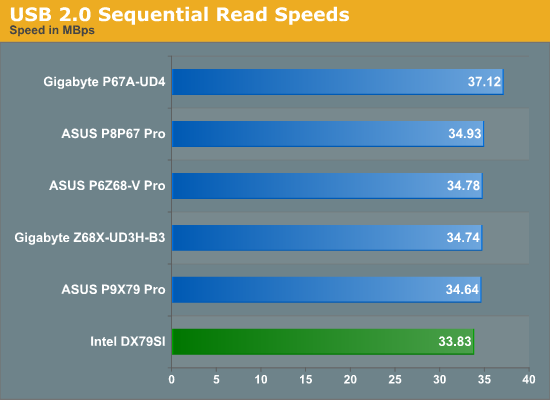

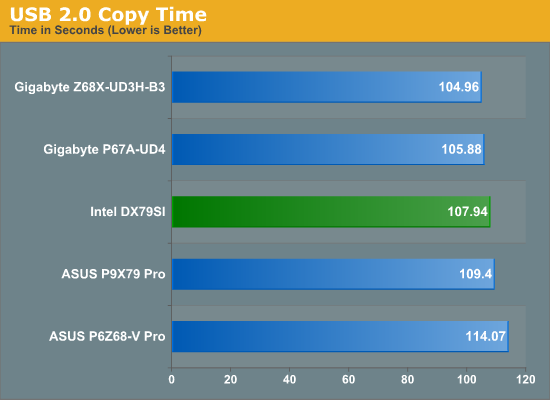
Despite the less than great sequential speeds, the Intel is board still as good as, if not better than, the ASUS P9X79 Pro.
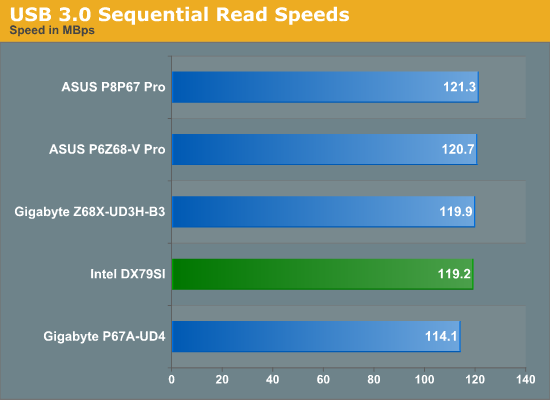
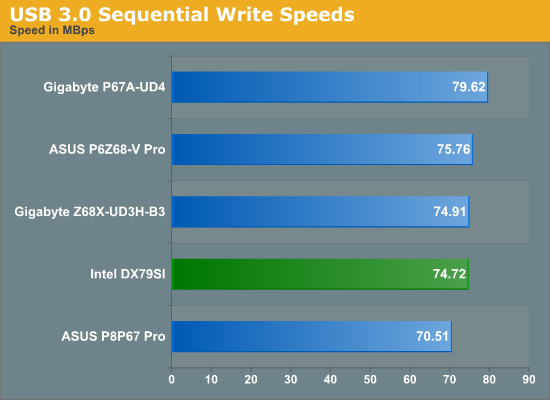
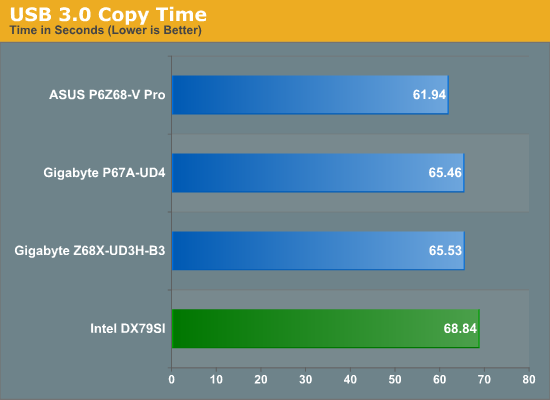
On the other hand, USB 3.0 speeds were relatively disappointing compared to previous chipsets.
SATA Testing
We also use CrystalDiskMark for SATA port testing. The operating system is installed on the Micron RealSSD C300, which is rated at 355 MB/s read and 215 MB/s write, and the sequential test is run at the 5 x 1000 MB level. This test probes the efficiency of the data delivery system between the chipset and the drive, or in the case of additional SATA ports provided by a third party controller, the efficiency between the controller, the chipset and the drive.


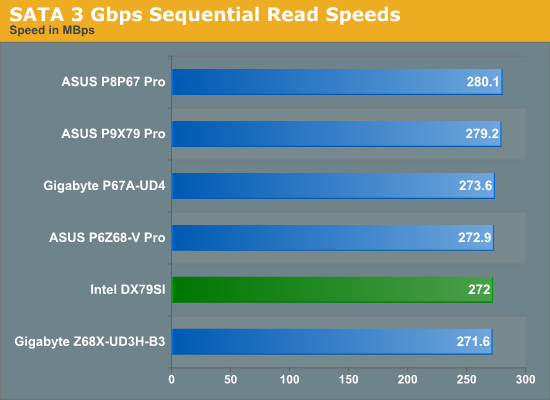
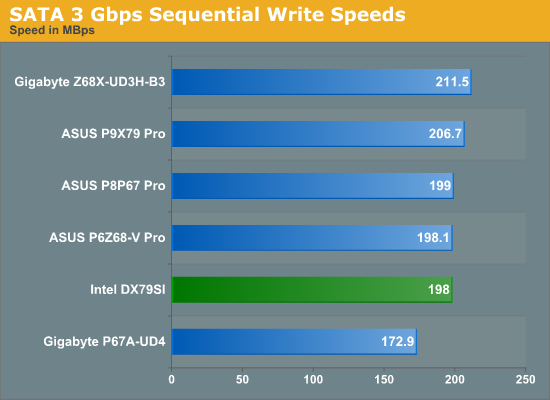
The dichotomy of the SATA results is relatively strange - while in SATA 6 Gbps the DX79SI performs well in sequential testing, the SATA 3 Gbps results are relatively low compared to others.
DPC Latency
Deferred Procedure Call latency is a way in which Windows handles interrupt servicing. In order to wait for a processor to acknowledge the request, the system will queue all interrupt requests by priority. Critical interrupts will be handled as soon as possible, whereas lesser priority requests, such as audio, will be further down the line. So if the audio device requires data, it will have to wait until the request is processed before the buffer is filled. If the device drivers of higher priority components in a system are poorly implemented, this can cause delays in request scheduling and process time, resulting in an empty audio buffer – this leads to characteristic audible pauses, pops and clicks. Having a bigger buffer and correctly implemented system drivers obviously helps in this regard. The DPC latency checker measures how much time is processing DPCs from driver invocation – the lower the value will result in better audio transfer at smaller buffer sizes. Results are measured in microseconds and taken as the peak latency while cycling through a series of short HD videos - under 500 microseconds usually gets the green light, but the lower the better.
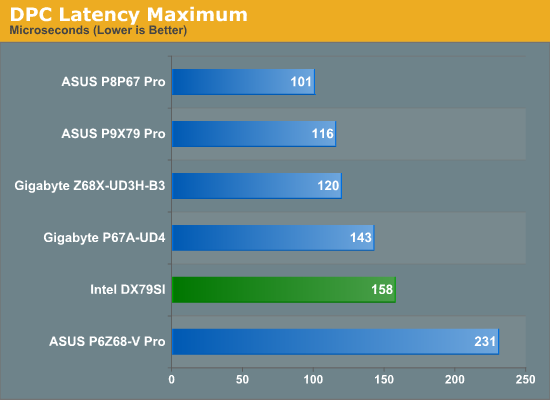
Our previous testing on the ASUS P9X79 showed that on average the DPC Latency was fairly low (~30 microseconds), with the occasional spike in the triple digits. On the other hand, the Intel DX79SI seemed to idle around double that of the ASUS board, with spikes into the 140-150s.










60 Comments
View All Comments
mdreed - Friday, November 18, 2011 - link
I had no idea Intel made their own mobos.mooninite - Friday, November 18, 2011 - link
*eye squint*Not sure if troll...
mygocarp - Friday, November 18, 2011 - link
I wasn't aware either.Granted, I don't really follow MBs much.
kmmatney - Friday, November 18, 2011 - link
They have pretty much been the world's biggest motherboard maker over the last 15 years or so. FoxConn used to make a lot of Intel branded motherboards in the past.Samus - Friday, November 18, 2011 - link
How can you not know Intel made their own motherboards? Even AMD at one point made a few boards to launch the K7 platform.I'm pretty sure Foxconn STILL manufactures Intel's boards, to Intel specification. All the components and connectors are usually Foxconn. You never see Amphenol and rarely see Molex-branded components. The PCB's usually have a Foxconn tag on an underside corner, indicating at least the PCB is manufactured by Foxconn.
vol7ron - Saturday, November 19, 2011 - link
He has to be a troll. What do we call comments trolls leave? Troop (troll poop, or the stuff trolls leave)?The first motherboard available for the Core2 series for months was an Intel brand, followed by ASUS and whomever else.
inighthawki - Saturday, November 19, 2011 - link
Or, maybe he's just an average tech user who browses a site like newegg and only knows of the more popular brands like ASUS, Gigabyte, etc. Intel may make a lot of boards, but that doesn't make them the most well known. Even I forgot until I read the article.vol7ron - Sunday, November 20, 2011 - link
I guess anything is possible, but I have to negate it with the probability of an average tech user leaving the first post.While it's possible he could be just some average user browsing some article on a site that he's kind of familiar with, or that he really just hadn't heard about Intel boards, since they are more known for their procs (and now SSDs); there are many readers here that subscribe to the RSS, that are generally the first to leave comments. I guess what I'm saying is that it's highly unlikely some average user would leave the first post, whereas that is generally reserved for those that keep up with the tech news. What do you think?
inighthawki - Sunday, November 20, 2011 - link
I just think you guys are being a little ridiculous that he's trolling and genuinely didn't know something. It's possible for even a more advanced tech user to have just never seen something before.Havor - Monday, November 21, 2011 - link
I have build over 500 PCs and only about 10 times have i used a Intel boards.All on request and 3 times it was for a server.
It comes from the old days, when chipsets ware big influence on performance, as all Intel mobos from ware 5~10% slower the ASUS or Abit or whomever.
But Intel never had a great name when it came to get the most out of there own chipsets!
And if you go to a e-seller, you only find Intel boards, some ware hidden away.
As there are people that prevere to have a "genuine" Intel board, from Foxconn ^_^